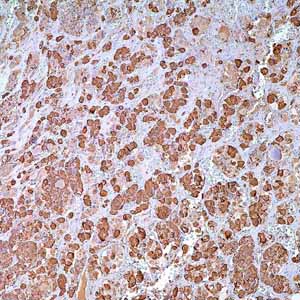

TSH (EP254) Rabbit Monoclonal Antibody
Specialties: Anatomic Pathology Neuropathology
Thyroid-stimulating hormone (also known as TSH or thyrotropin) is a peptide hormone synthesized and secreted by thyrotrope cells in the anterior pituitary gland which regulate the endocrine function of the thyroid gland. TSH is a glycoprotein and consists of two subunits, the alpha and the beta subunit, which are non-covalently bound to one another. The alpha subunit of TSH is also present in two other pituitary glycoprotein hormones: Follicle stimulating hormone and luteinizing hormone and, in primates, in the placental hormone chorionic gonadotropin. Each of these hormones also has a unique beta subunit, which provides receptor specificity. In other words, TSH is composed of alpha subunit bound to the TSH beta subunit, and TSH associates only with its own receptor. Free alpha and beta subunits have essentially no biological activity. Anti-TSH reacts with TSH-producing cells (thyrotrophs), and is a useful marker in classification of pituitary tumors and the differential identification of primary and metastatic tumors in the pituitary gland.1-5
- Batanero E, et al. The neural and neuro-endocrine component of the human thymus. II. Hormone immunoreactivity. Brain Behav Immun. 1992; 6:249-64.
- Sanno N, et al. GH and PRL gene expression by nonradioisotopic in situ hybridization in TSH-secreting pituitary adenomas. J Clin Endocrinol Metab. 1995; 80:2518-22.
- La Rosa S, et al. Detection of gonadotropin-releasing hormone receptor in normal human pituitary cells and pituitary adenomas using immunohistochemistry. Virchows Arch. 2000; 437:264-9.
- Kuzuya N, et al. Endocrine and immunohistochemical studies on thyrotropin (TSH)-secreting pituitary adenomas: responses of TSH, alpha-subunit, and growth hormone to hypothalamic releasing hormones and their distribution in adenoma cells. J Clin Endocrinol Metab. 1990; 71:1103-11.
- Clore JN, et al. Thyrotropin-induced hyperthyroidism: evidence for a common progenitor stem cell. Am J Med Sci. 1988; 295:3-5.
Specifications
- Reactivity: paraffin
- Visualization: cytoplasmic
- Control: pituitary
- Dilution Range: 1:100-1:500*
Package Inserts
IFU
- IVD Rev. 2.0 (CMC21131020)
Have a different keycode?
Click Here
Learn how to obtain your SDS
Ordering Information
For in vitro diagnostic (IVD) use in USA
| 0.1 mL concentrate | 211R-14 |
| 0.5 mL concentrate | 211R-15 |
| 1 mL concentrate | 211R-16 |
| 1 mL predilute | 211R-17 |
| 7 mL predilute | 211R-18 |
For in vitro diagnostic (IVD) use in Canada
| 0.1 mL concentrate | 211R-14 |
| 0.5 mL concentrate | 211R-15 |
| 1 mL concentrate | 211R-16 |
| 1 mL predilute | 211R-17 |
| 7 mL predilute | 211R-18 |
For in vitro diagnostic (IVD) use in Europe
| 0.1 mL concentrate | 211R-14 |
| 0.5 mL concentrate | 211R-15 |
| 1 mL concentrate | 211R-16 |
| 1 mL predilute | 211R-17 |
| 7 mL predilute | 211R-18 |
For research use only (RUO) in Japan
| 0.1 mL concentrate | 211R-14-RUO |
| 0.5 mL concentrate | 211R-15-RUO |
| 1 mL concentrate | 211R-16-RUO |
| 1 mL predilute | 211R-17-RUO |
| 7 mL predilute | 211R-18-RUO |
To request information on this product in additional countries, please click the button below.









